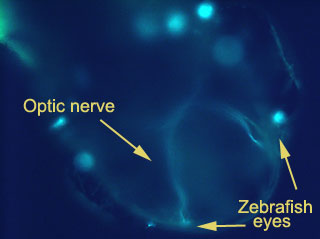Neurons: A Fish-Eye View of the Brain
Speed-dating neurons make connections
Researchers in the Smith lab have also been able to watch the development of single neurons as they grow and connect to each other to complete the optical system. What they’ve seen helps explain how the brain's enormous complexity emerges.
It now appears that brain organization happens in stages. As a developing neuron grows, it sends out tiny exploratory branches called filopodia. These projections search for partners in an effort to make connections and form synapses. (It's a bit like neural “speed dating.”) Each branch makes tens or hundreds of contacts with other neurons in the densely packed tissue surrounding it, but only a small percentage of these “dates” result in cellular “marriages.”
Once formed, the synapse becomes a hot spot; the connected neuron sends out new filopodia, thus increasing the number of connections it has with other neurons. In this way, the neuron is called upon more often, causing it to send out more filopodia and make still more connections. Researchers have found that as a zebrafish begins to see, only certain connections and pathways are useful, and the cell begins to lose unnecessary connections. This radical pruning adds precision to the circuit.
Researchers in the Smith lab have also been able to watch the development of single neurons as they grow and connect to each other to complete the optical system. What they’ve seen helps explain how the brain's enormous complexity emerges.
It now appears that brain organization happens in stages. As a developing neuron grows, it sends out tiny exploratory branches called filopodia. These projections search for partners in an effort to make connections and form synapses. (It's a bit like neural “speed dating.”) Each branch makes tens or hundreds of contacts with other neurons in the densely packed tissue surrounding it, but only a small percentage of these “dates” result in cellular “marriages.”
Once formed, the synapse becomes a hot spot; the connected neuron sends out new filopodia, thus increasing the number of connections it has with other neurons. In this way, the neuron is called upon more often, causing it to send out more filopodia and make still more connections. Researchers have found that as a zebrafish begins to see, only certain connections and pathways are useful, and the cell begins to lose unnecessary connections. This radical pruning adds precision to the circuit.





A microscope image showing nerve cells developing in the visual system of a zebrafish embryo. The nerve cells glow green because they express a gene for
green fluorescent protein
(GFP). This image was taken looking straight down on the zebrafish’s head
The wiring process happens quickly: one filopodium explores for about five minutes, retracting if it doesn’t make any connections. The bulk of this massive connection-making effort happens surprisingly quickly; the basic wiring of the zebrafish visual system is completed between the third and the eighth day of the fish's life. Though its brain continues to grow, and the number of neurons it contains may increase a hundredfold, the primary connections between neurons are laid out in these early days. In humans, such intense brain development happens in stages over the first few years of life—but it’s now thought that our brain wiring continues to change and grow throughout our lives.
Scientists used to believe that once an animal’s brain was wired up, the resulting network was final and no new connections were possible. But recent research is showing that when our brains are challenged to learn new things, old neurons can begin “dating” again, making new connections. In one experiment, adult owls re-learned to see and hunt after having their vision altered by perspective-shifting glasses. Another researcher showed that after practicing for just one week, people learning to play piano showed an expansion in the brain area devoted to finger movement. Contrary to popular belief, old dogs may well be able to learn new tricks—because old brains may continue to grow and change.
Scientists used to believe that once an animal’s brain was wired up, the resulting network was final and no new connections were possible. But recent research is showing that when our brains are challenged to learn new things, old neurons can begin “dating” again, making new connections. In one experiment, adult owls re-learned to see and hunt after having their vision altered by perspective-shifting glasses. Another researcher showed that after practicing for just one week, people learning to play piano showed an expansion in the brain area devoted to finger movement. Contrary to popular belief, old dogs may well be able to learn new tricks—because old brains may continue to grow and change.


